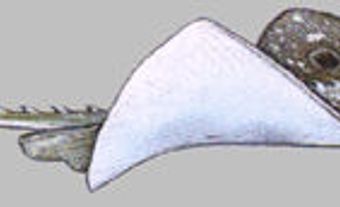The tuna is a swift, elegant marine fish of class Actinopterygii, order Perciformes, family Scombridae (mackerels). There are about 54 species in the family, including kingfishes, mackerels, tunas and bonitos. Strictly speaking, tunas are restricted to the tribe Thunnini, which includes 3-9 genera, depending on the authority. For present purposes, 15 species of tuna in 5 genera (Allothunnus, Auxis, Euthynnus, Katsuwonus and Thunnus) are recognized. Tunas are wide-ranging, pelagic (open sea) fishes, inhabiting tropical and temperate waters worldwide. In Canada, 8 species occur: bullet mackerel or bullet tuna (Auxis rochei), little tunny (Euthynnus alletteratus), skipjack tuna (Katsuwonus pelamis), albacore (Thunnus alalunga), yellowfin tuna (T. albacares), bigeye tuna (T. obesus) and bluefin tuna (T. thynnus in the Atlantic and T. orientalis in the Pacific). The blackfin tuna (T. atlanticus) ranges north to Massachusetts and may enter the southern Canadian Atlantic in summer.
Description
Small species weigh under 9 kg but larger species may grow to weights of 45-679 kg. All tunas have hydrodynamically efficient streamlined bodies and widely forked tails. Behind the second dorsal fin and the anal fin are a series of small finlets. Individual species are strikingly colourful. True tunas are unusual among fishes because they are warm blooded and can maintain a body temperature of up to 10° (Celsius) above surrounding waters through retention of heat from muscle contractions.
Diet
Tunas are exceedingly active, ranging widely over the oceans and travelling thousands of kilometres on extensive migrations. They consume large quantities of crustaceans, squids and fishes (up to 25% of their body weight daily) to meet their energy requirements.
Significance of Fishery
The commercial fisheries employ purse seines, trapnets, longlines and angling. Each year some 5500 t of tuna with an average value of nearly $27 million are landed by commercial fishers. Tuna are canned or sold fresh. The bluefin tuna fishing season on Canada's East Coast generally runs from late July to late November. This very valuable food fish is caught by rod and reel or tended line and shipped directly or retained alive and fattened for shipment to Japan, where it is sold fresh for the sashimi market. Bluefin is also highly sought by sport fishers in Atlantic Canada. The world's record rod-caught bluefin (679 kg) was taken off Cape Breton Island in 1979; the record is still valid.

 Share on Facebook
Share on Facebook Share on X
Share on X Share by Email
Share by Email Share on Google Classroom
Share on Google Classroom





